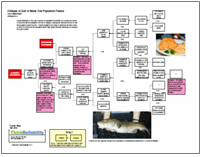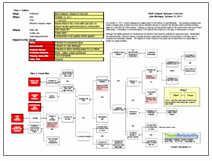By Kim Smiley
An entrepreneur created a massive bloom of plankton after he dumped a hundred tons of iron dust into the Pacific Ocean off western Canada last June. This action has sparked outrage because an individual manipulated the environment without government approval or scientific oversight.
A Cause Map, a visual format for performing a root cause analysis, can be built to analyze this issue. The first step in building a Cause Map is to determine how the issue impacts the overall goals. The next step is to ask “why” questions and the answers are then organized into cause-and-effect relationships so that all factors that contributed to a problem are laid out in an intuitive format. In this example, impacts to several goals are worth considering.
 The first issue is that nobody knows exactly how the environment will respond to this much iron being put into the ocean. The environmental impacts may well turn out to be minimal, but this is by far the largest experiment of this type done to date so nobody really knows how big the impact will be. The experiment is also particularly worrisome because there wasn’t adequate scientific oversight or approvals for it. The man conducting the experiment was an entrepreneur hoping to make money. A local tribe hired the entrepreneur to fertilize the ocean with iron in a bid to increase the local salmon population by increasing their food supply. Adding iron to the ocean can create a rapid increase in the phytoplankton population, which are the base of the aquatic food chain, because iron is often the limiting nutrient for phytoplankton growth. Iron is necessary for photosynthesis and thus phytoplankton growth. But iron is also highly insoluble in sea water so large areas of the ocean have limited iron supplies.
The first issue is that nobody knows exactly how the environment will respond to this much iron being put into the ocean. The environmental impacts may well turn out to be minimal, but this is by far the largest experiment of this type done to date so nobody really knows how big the impact will be. The experiment is also particularly worrisome because there wasn’t adequate scientific oversight or approvals for it. The man conducting the experiment was an entrepreneur hoping to make money. A local tribe hired the entrepreneur to fertilize the ocean with iron in a bid to increase the local salmon population by increasing their food supply. Adding iron to the ocean can create a rapid increase in the phytoplankton population, which are the base of the aquatic food chain, because iron is often the limiting nutrient for phytoplankton growth. Iron is necessary for photosynthesis and thus phytoplankton growth. But iron is also highly insoluble in sea water so large areas of the ocean have limited iron supplies.
The entrepreneur also hoped to find a way to cash in on carbon offset credits because phytoplankton blooms may be a way to sequester carbon and improve greenhouse gas numbers in the environment. This may work because phytoplankton absorb carbon dioxide during their life and when they die they sink into the ocean, taking the carbon dioxide with them and removing it from the atmosphere.
The second issue is that there are known risks associated with large blooms of phytoplankton. They can negatively affect the other aquatic life in the region because large blooms can deplete the ocean of oxygen. This occurs because the populations of other microorganisms will increase since the increase in phytoplankton provides a larger food supply. Some of these other microorganisms absorb oxygen so more of them means less oxygen for other aquatic life. Phytoplankton live near the surface, but they sink as they die so a bloom will impact the food supply and oxygen levels throughout the entire depth of the ocean.
A final goal worth considering is the impact this has on public opinion. Iron fertilization is a contentious issue to begin with because many people are opposed to purposefully manipulating the environment. When somebody dumps tons of iron into the ocean without solid scientific involvement it understandablely outrages the public. The negative press will make it harder for any legitimate scientific research being done in this field.
This issue has been covered by The New York Times , The New Yorker and NBC news. Click on any of these links to learn more about this issue. Click on “Download PDF” above to view a high level Cause Map.









